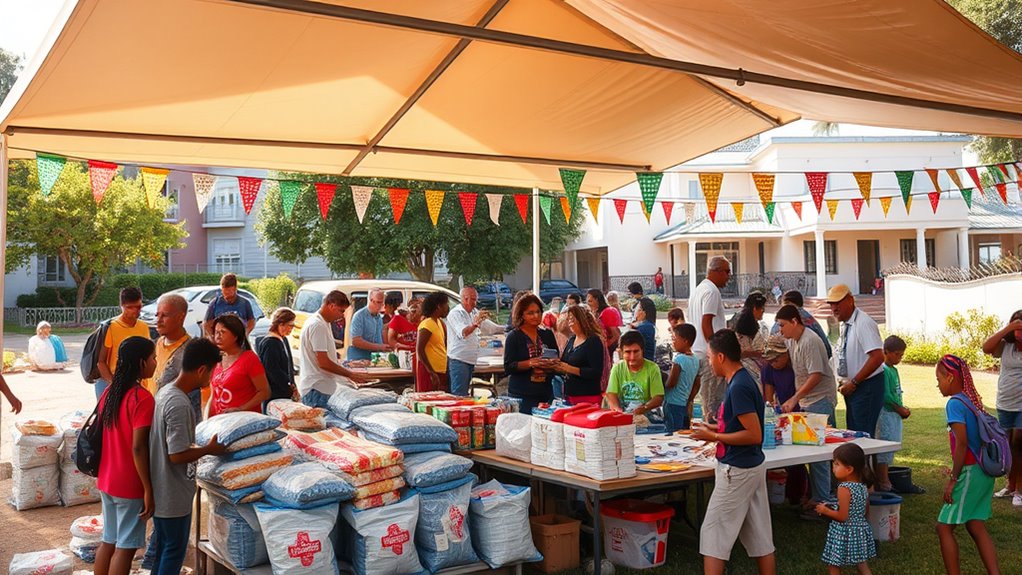Community resilience hubs are central spaces designed to boost neighborhood strength by providing resources, information, and support during disasters. They facilitate community engagement, foster trust, and bring together local leaders, responders, and residents for preparedness and response. These hubs offer emergency supplies, mental health support, and education, creating stronger social bonds. Building such hubs requires planning, partnerships, funding, and inclusive outreach. Stay with us to discover how you can help create resilient, prepared communities.
Key Takeaways
- Community resilience hubs serve as accessible centers for resources, support, and coordination during disasters, enhancing neighborhood safety.
- They involve residents through engagement and participation to build trust, ownership, and collective disaster preparedness.
- Hubs provide essential supplies, mental health support, and emergency training to strengthen community response capabilities.
- Partnerships with local organizations, leaders, and volunteers amplify resilience efforts and resource sharing.
- Regular drills, educational programs, and culturally inclusive outreach ensure communities are well-prepared for emergencies.
What Are Community Resilience Hubs?
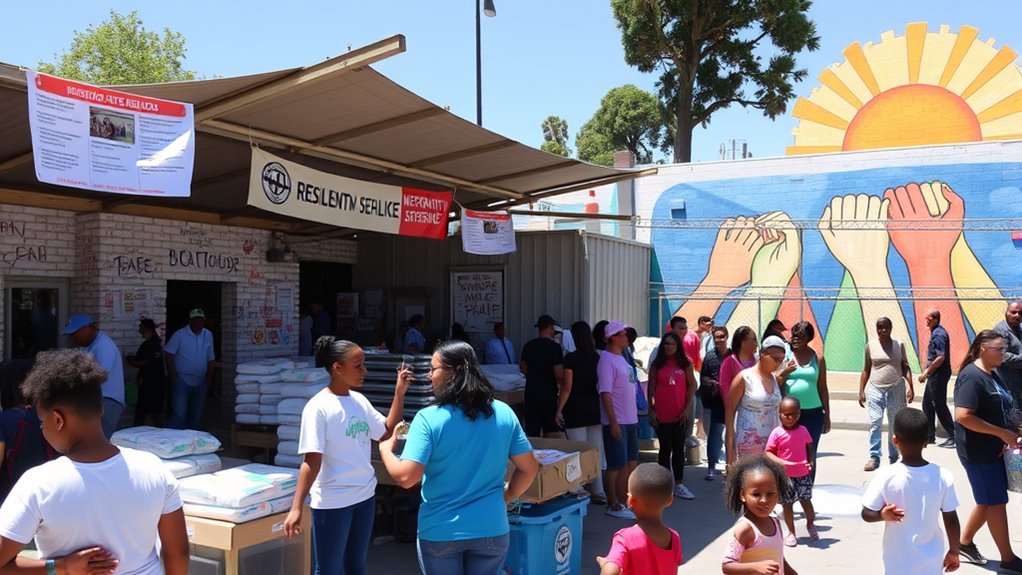
What exactly are community resilience hubs? They’re central locations designed to strengthen neighborhoods through strategic urban planning, ensuring communities can effectively respond to emergencies. These hubs serve as accessible points for resources, information, and support during disasters, playing a crucial role in disaster recovery efforts. By integrating into city layouts, resilience hubs help coordinate relief activities, provide shelter, and assist vulnerable populations. They are more than just emergency centers; they’re proactive tools that enhance a community’s ability to withstand and bounce back from crises. Their presence encourages collaboration among local agencies and residents, fostering a sense of preparedness and unity. Overall, resilience hubs are essential for building safer, more resilient communities capable of handling the unpredictable challenges posed by disasters.
The Role of Resilience Hubs in Emergency Preparedness
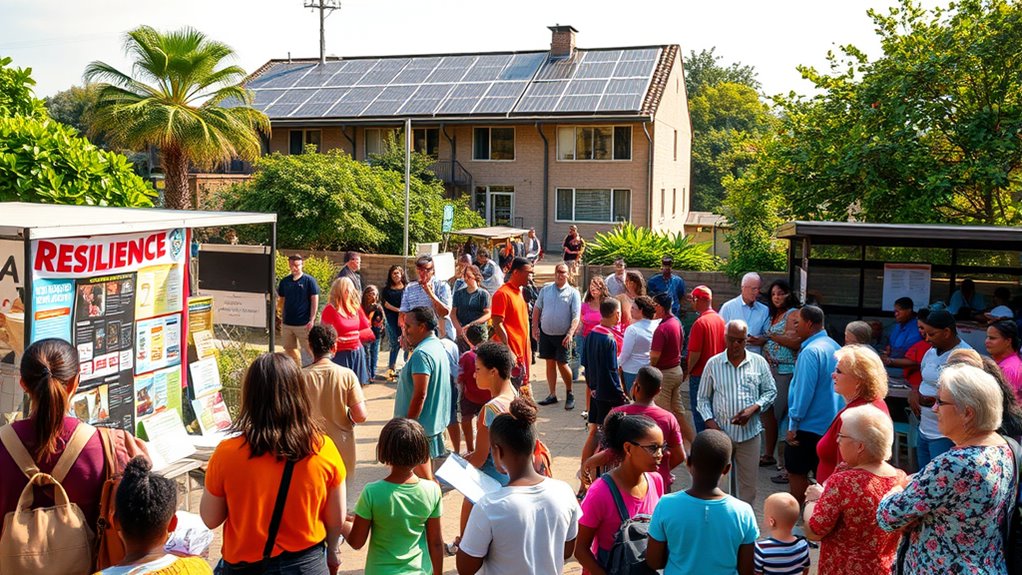
Resilience hubs play a crucial role in emergency preparedness by serving as centralized points for coordination and response. They provide a safe space where community members can access vital resources and information quickly. Understanding disaster psychology helps you recognize how stress and trauma affect individuals during crises, making psychological first aid essential. A well-trained staff can deliver immediate emotional support, which helps reduce fear and confusion among community members. By integrating mental health support with logistical aid, these hubs help communities recover more effectively. Your participation ensures that responders can deliver timely comfort and reassurance, which is vital for maintaining community stability. Incorporating AI security technologies into resilience hub operations can further enhance the safety and effectiveness of emergency responses. Additionally, implementing community engagement strategies fosters trust and cooperation among residents, improving overall disaster response efforts. Enhancing disaster preparedness through education and drills can also strengthen community resilience. Ultimately, resilience hubs strengthen your community’s ability to face disasters with resilience, ensuring both physical safety and emotional well-being are prioritized during emergencies.
How Resilience Hubs Foster Community Engagement
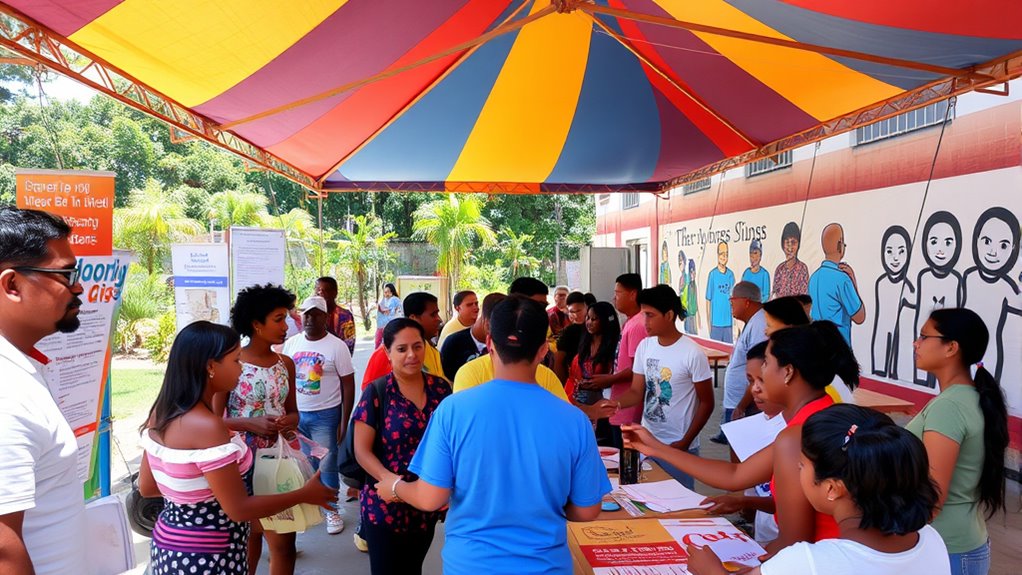
By involving community members directly in emergency preparedness efforts, resilience hubs create opportunities for meaningful engagement. When residents participate in planning and activities, they develop a sense of ownership and responsibility, which strengthens community participation. Resilience hubs often empower local leadership by encouraging residents to take active roles, fostering trust and collaboration. This involvement guarantees that responses are tailored to community needs and that everyone feels invested in safety efforts. As residents share their knowledge and concerns, resilience hubs become spaces of open communication and collective problem-solving. This inclusive approach builds stronger bonds among neighbors and promotes a culture of preparedness. Additionally, active listening and empathy are essential skills fostered through these engagement efforts, ensuring that diverse community voices are heard and valued. Incorporating community engagement strategies can further enhance participation and trust in disaster readiness initiatives. Moreover, leveraging energetic alignment among community members can amplify collective resilience and foster a positive outlook during crises. Encouraging community participation in resilience activities creates a more connected and prepared neighborhood. Ultimately, community engagement through local leadership enhances the effectiveness of resilience hubs and ensures they serve the community’s best interests. Building trust and collaboration within the community further reinforces resilience and ensures a more effective response to disasters.
Key Features of Effective Resilience Hubs

Effective resilience hubs center around accessible resource storage that communities can rely on during emergencies. They also incorporate strong engagement strategies to connect residents and foster trust. By combining these features, hubs become essential assets that strengthen community resilience and preparedness. A well-designed hub also considers the importance of color accuracy in visual displays to ensure clear communication during crises. Incorporating privacy considerations ensures that community members feel secure when sharing feedback and participating in planning efforts. Additionally, understanding the diverse emotional support needs of community members can enhance participation and trust in resilience initiatives. Integrating sound therapy science can also be beneficial, as calming auditory elements may help alleviate stress and promote a sense of safety during emergency situations.
Centralized Resource Storage
Centralized resource storage is a critical feature that guarantees communities can quickly access essential supplies during emergencies. By implementing effective storage solutions, resilience hubs ensure that essential items like food, water, first aid kits, and emergency tools are readily available when needed most. This setup streamlines resource coordination, reducing delays caused by scattered supplies across multiple locations. When you have a well-organized central storage, response times improve, and community members feel more confident during crises. Proper labeling, inventory management, and secure facilities are indispensable to maintaining these resources. Centralized storage not only enhances preparedness but also supports ongoing community resilience efforts by ensuring that everyone can access the supplies they need, precisely when they need them. Incorporating inventory management systems further optimizes resource tracking and replenishment, ensuring supplies remain sufficient and well-maintained. Additionally, regular storage facility inspections help identify potential issues before they impact supply availability. Maintaining a storage protocol ensures consistent practices and reduces the risk of mismanagement or contamination of supplies. Regular training on emergency response procedures can further improve the efficiency of resource distribution during crises.
Community Engagement Strategies
How do resilience hubs foster a sense of ownership and trust within their communities? They do this through active community engagement strategies, focusing on volunteer coordination and cultural inclusivity. By involving residents in planning and decision-making, you empower them to take ownership of the hub’s success. Making cultural inclusivity a priority means respecting diverse backgrounds, languages, and traditions, making everyone feel valued. Volunteers play a vital role, helping build relationships and trust while delivering critical services. Here’s how these strategies work:
| Approach | Impact |
|---|---|
| Volunteer coordination | Builds community bonds and ensures resource efficiency |
| Cultural inclusivity | Fosters respect, belonging, and diverse participation |
Additionally, emphasizing appropriate communication methods ensures that information is accessible and resonates with all community members, strengthening trust and engagement. Incorporating community feedback further enhances the effectiveness of these strategies by aligning initiatives with residents’ needs and preferences. Implementing community leadership can also promote sustained involvement and shared responsibility within the community. Engaging residents in planning processes helps ensure that the hub’s initiatives are relevant and effective for the community’s unique needs. Developing trust-building activities can also deepen connections and foster long-term resilience among residents.
Building Partnerships for Stronger Resilience Networks
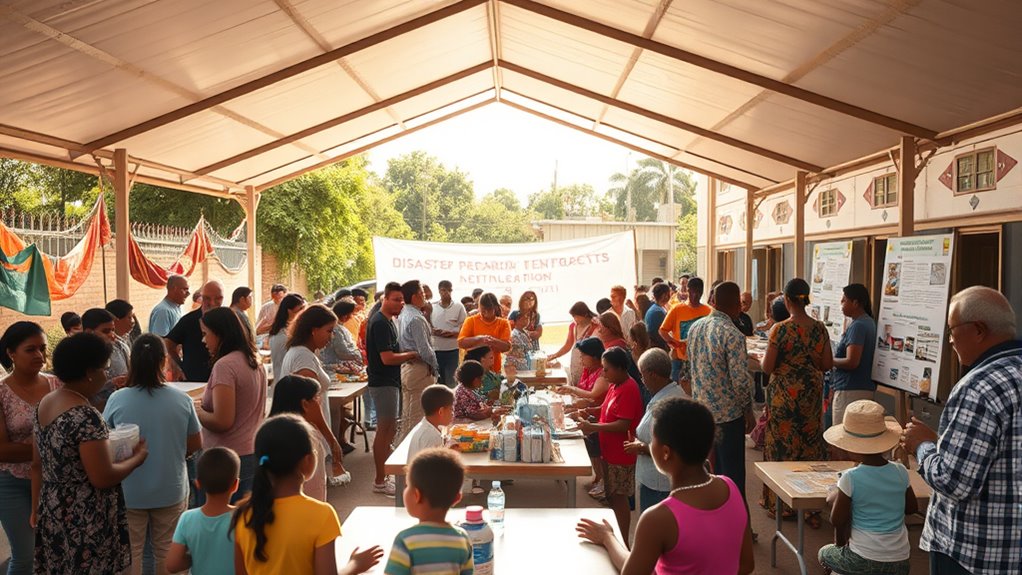
Building strong resilience networks requires forging meaningful partnerships among diverse community stakeholders. You need to bring together local leaders, emergency responders, nonprofits, and residents to create a unified approach. Effective disaster communication is key; by establishing clear channels, everyone stays informed and prepared. Volunteer coordination also plays a vital role, ensuring that community members can support one another during crises. You should foster trust and open dialogue, encouraging collaboration across sectors. Creating these partnerships helps pool resources, share expertise, and develop all-encompassing response plans. When everyone works together, your resilience network becomes more adaptable and capable of handling emergencies efficiently. Ultimately, strong partnerships lay the foundation for a resilient community that can better withstand and recover from disasters.
Resources and Services Offered by Resilience Hubs
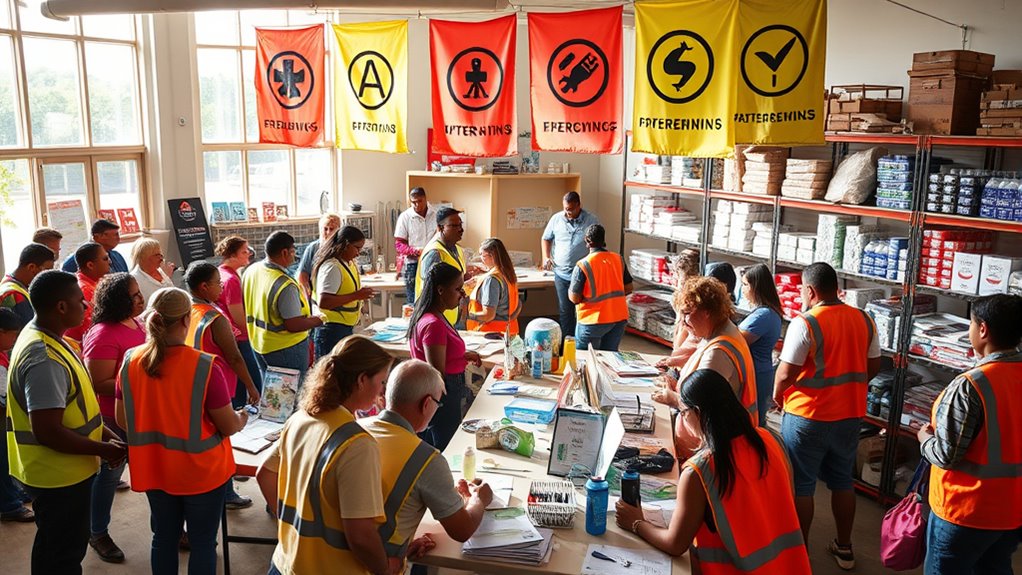
Resilience hubs provide essential resources like emergency preparedness tools and supplies to help your community respond quickly during crises. They also offer support services such as counseling and assistance for those in need. Additionally, educational outreach programs keep residents informed and empowered to build a safer, more resilient neighborhood.
Emergency Preparedness Resources
Have you ever wondered what resources are available to help you prepare for emergencies? Resilience hubs offer essential tools for effective disaster communication and emergency supply planning. They provide training, workshops, and checklists to guarantee you’re ready when disaster strikes. These resources help you build emergency kits, develop communication plans, and stay informed during crises.
| Resource Type | Description | How It Helps |
|---|---|---|
| Disaster Communication | How to stay connected during crises | Keeps you informed and safe |
| Emergency Supply Planning | Creating your emergency kit | Ensures supplies are ready |
| Preparedness Workshops | Hands-on disaster readiness | Builds confidence and skills |
| Resource Maps | Locations of supplies and services | Simplifies access during emergencies |
Community Support Services
Did you know that community support services offered by resilience hubs are essential during emergencies? These services help maintain mental health and strengthen social cohesion when disaster strikes. Resilience hubs provide access to crisis counseling, peer support groups, and mental health resources to help you cope. They also facilitate community connections, fostering a sense of unity and shared responsibility.
- Crisis and mental health counseling for individuals and families
- Peer support networks to build social cohesion
- Resource coordination for vulnerable populations
- Information hubs for community updates and assistance
These services assure you’re not alone during tough times, reinforcing community resilience and promoting emotional well-being for everyone involved.
Educational Outreach Programs
Building on community support services, educational outreach programs offered by resilience hubs play a crucial role in empowering residents with knowledge and skills to face emergencies. These programs boost public awareness about potential hazards and preparedness strategies, ensuring you understand how to protect yourself and your community. You’ll find workshops and seminars designed to teach vital skills, from basic first aid to emergency communication. Volunteer training is also a key component, equipping residents to assist during crises and strengthen community response efforts. By participating, you become an active part of disaster preparedness, helping spread awareness and support. These outreach initiatives foster a culture of readiness, ensuring everyone is informed, prepared, and resilient in the face of emergencies.
Training and Education Initiatives at Resilience Centers
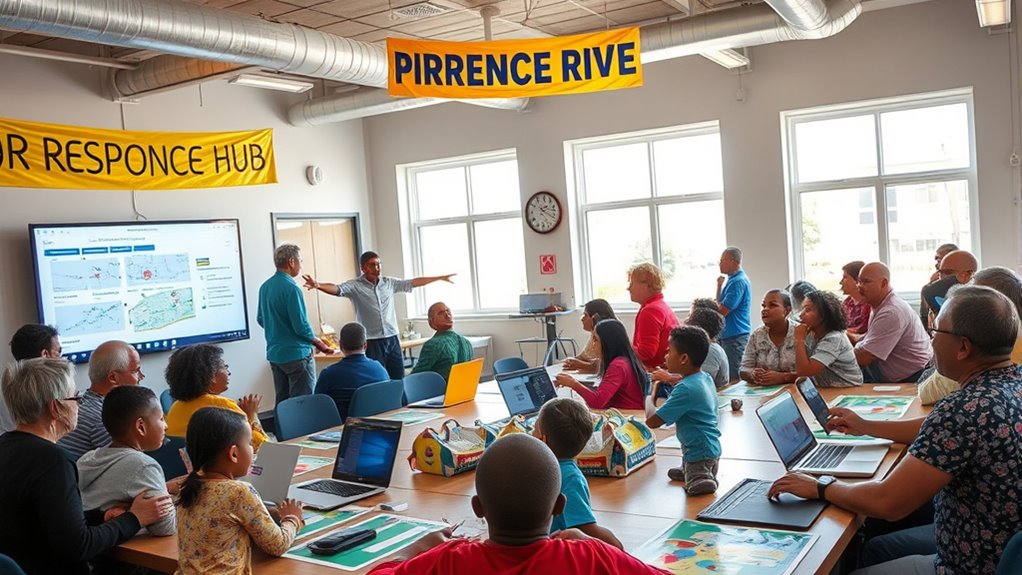
How do resilience centers guarantee communities are prepared for emergencies? They focus on thorough training and education initiatives that empower residents. Through regular disaster simulations, you can practice response strategies in realistic scenarios, building confidence and coordination. Volunteer training programs teach community members essential skills, ensuring they’re ready to assist during crises. These initiatives foster a proactive mindset and strengthen local resilience.
- Conduct realistic disaster simulations to identify gaps and improve response plans
- Offer specialized volunteer training to expand community capabilities
- Provide accessible educational workshops on emergency preparedness
- Develop tailored resources for vulnerable populations to ensure inclusivity
Case Studies: Successful Resilience Hub Projects
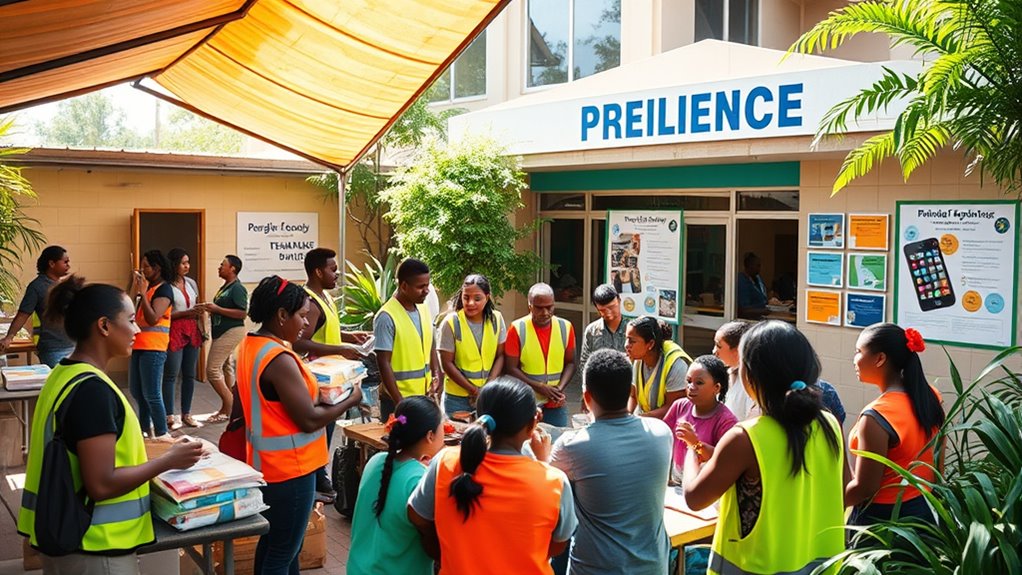
Many resilience hubs have successfully transformed their communities by implementing innovative programs and engaging residents in preparedness efforts. One effective approach involves integrating urban greening projects, which improve local environments and foster community pride. These hubs often partner with local artists and organizations to create arts collaborations, making preparedness messages more compelling and accessible. For example, some hubs use murals, community gardens, or outdoor performance spaces to promote resilience themes, encouraging participation and awareness. These projects not only beautify neighborhoods but also strengthen social bonds, making communities more resilient in emergencies. By blending urban greening with arts collaborations, resilience hubs turn preparedness into a collective, inspiring experience that empowers residents and builds lasting community resilience.
Challenges and Opportunities in Establishing Hubs
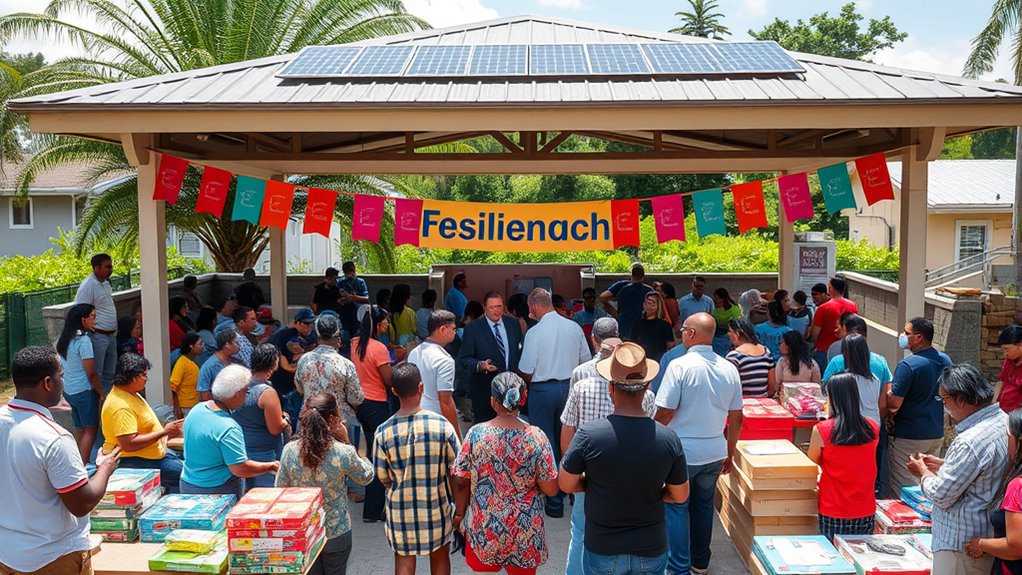
Establishing resilience hubs often faces hurdles like funding shortages, resource gaps, and infrastructure limitations that can slow progress. Engaging the community effectively is essential but can be challenging without the right strategies in place. Addressing accessibility issues guarantees that all community members can benefit, opening up opportunities for broader impact.
Funding and Resource Gaps
Funding and resource gaps pose significant challenges for the development of Community Resilience Hubs, often limiting their ability to serve vulnerable populations effectively. You might encounter funding challenges that restrict start-up costs or ongoing operations, making sustainability difficult. Inefficient resource allocation can lead to underutilized spaces or services, reducing impact. Securing consistent funding streams remains a hurdle, especially with competing priorities. Additionally, lack of access to grants or public funding can impede expansion efforts. To address these issues, consider exploring diverse funding sources, including local government, private donors, and partnerships. Effective resource management becomes vital to maximize limited funds. Overcoming these gaps requires strategic planning and community involvement to ensure hubs are adequately financed and equipped to meet needs.
Community Engagement Strategies
How can communities effectively engage residents to guarantee that resilience hubs truly meet their needs? You should focus on volunteer coordination to assure diverse voices are heard and involved. Building strong relationships with local organizations and leaders encourages participation and trust. Prioritize cultural inclusivity by designing outreach efforts that respect different backgrounds, languages, and traditions. Offer multilingual materials and hold culturally sensitive meetings to foster engagement. Recognize community-specific needs through surveys or informal conversations, making residents feel valued and heard. This inclusive approach helps identify unique challenges and solutions, increasing the likelihood of sustained involvement. When residents see their perspectives reflected, they’re more likely to support and utilize the resilience hubs, strengthening community resilience before disasters strike.
Infrastructure and Accessibility
Building resilient community hubs requires careful planning to overcome infrastructure and accessibility challenges. You need to take into account how urban planning can create spaces that are easy to reach and serve diverse populations. Upgrading technological infrastructure ensures reliable communication and resource sharing during emergencies. Accessibility issues, such as transportation barriers or physical disabilities, must be addressed to include all community members.
Key considerations include:
- Integrating transit options with hub locations for easy access
- Designing for universal accessibility standards
- Investing in robust technological infrastructure for connectivity
- Collaborating with urban planners to identify ideal sites
Steps to Create a Community Resilience Hub in Your Area

Wondering where to start when creating a community resilience hub? Begin by evaluating your area’s needs through urban planning. Map out key locations, identify vulnerable populations, and determine existing resources to support disaster recovery. Engage local officials, community groups, and residents early in the process to gather input and foster ownership. Develop a clear plan that outlines the hub’s purpose, facilities, and operations during emergencies. Secure funding through grants, government programs, or partnerships. Next, identify a suitable site that’s accessible and equipped for emergency use. Establish partnerships with emergency services, healthcare providers, and volunteers. Regular drills and community outreach will ensure the hub remains prepared for disasters. Taking these steps builds a resilient, well-coordinated community ready to recover faster.
Frequently Asked Questions
How Do Resilience Hubs Adapt to Different Community Needs?
You adapt resilience hubs to community needs by actively engaging local residents and understanding their unique circumstances. You incorporate cultural considerations to make sure services are accessible and respectful of diverse traditions. This approach allows you to tailor resources and programming, fostering stronger community bonds. By listening to residents and involving them in planning, you create a resilient hub that genuinely supports everyone, especially during emergencies.
What Funding Options Are Available for Establishing Resilience Hubs?
You can explore various funding options like grant opportunities from government agencies, foundations, and nonprofits to establish resilience hubs. Public-private partnerships also provide valuable support, allowing you to collaborate with local businesses and organizations. Additionally, consider community fundraising and sponsorships. Combining these sources helps secure the necessary funds, ensuring your resilience hub effectively meets local needs and enhances disaster preparedness in your community.
How Can Residents Volunteer or Contribute to Resilience Hubs?
They say “many hands make light work,” and you can play a essential role in resilience hubs. You can volunteer through local programs, participating in community training sessions to learn skills and support disaster preparedness. Your involvement helps strengthen the community’s response, ensuring everyone is ready. By volunteering, you contribute time and expertise, making resilience hubs more effective and fostering a stronger, more connected neighborhood in times of need.
What Technology Is Used to Coordinate Emergency Responses at Hubs?
You use technology like emergency communication systems to coordinate responses efficiently at hubs. These tools enable real-time updates, ensuring everyone stays informed. Resource management software helps you track supplies, personnel, and logistics, streamlining operations during crises. By leveraging these technologies, you can respond swiftly, allocate resources effectively, and maintain clear communication, ultimately strengthening your community’s resilience and ensuring everyone’s safety during disasters.
How Do Resilience Hubs Measure Their Effectiveness Over Time?
Your resilience hub measures its effectiveness over time by tracking key indicators like community engagement levels and resource allocation efficiency. You might find that participation rates or feedback surveys act as essential signs of success, revealing how well the community is prepared and connected. Regular assessments ensure the hub’s efforts aren’t just a flicker but a blazing torch guiding disaster readiness, helping you adapt and grow stronger with each challenge.
Conclusion
By supporting resilience hubs, you help your community prepare for disasters—just like the pioneers relied on their sturdy forts. These centers aren’t just modern innovations; they’re essential for building strength and unity. When you get involved, you become part of a resilient network that can weather any storm. Remember, as the saying goes, “forewarned is forearmed.” Together, you can turn uncertainty into preparedness and foster a safer, stronger neighborhood for all.
